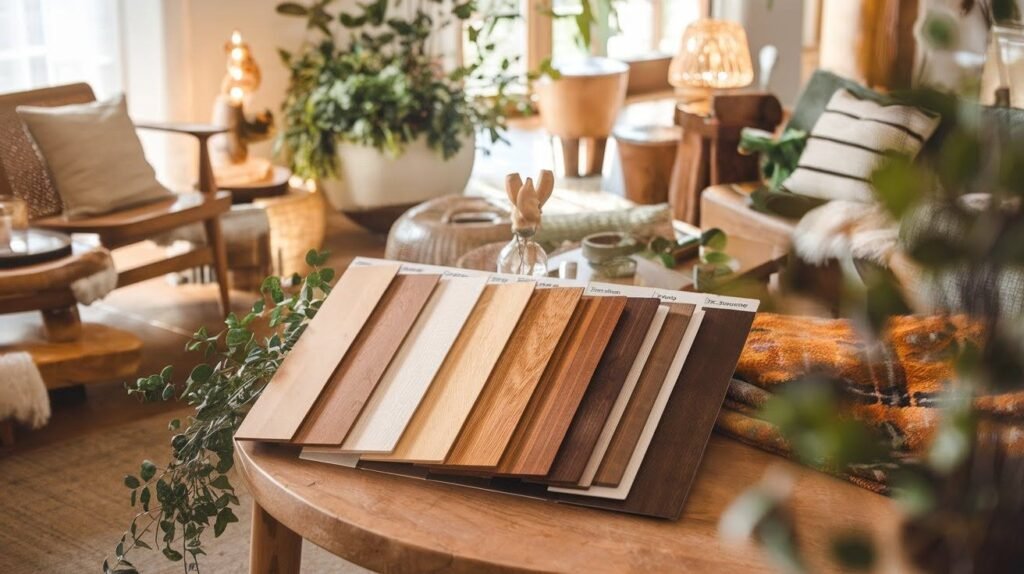Choosing the right wood tone can make or break your interior design. Too light, and your space feels cold. Too dark, and it becomes overwhelming. Getting it wrong leads to costly mistakes and endless frustration.
This guide fixes that. You’ll get a complete wood tones chart with real examples for every room. We’ll show you how to match tones with existing furniture, walls, and lighting, and which finishes work best in kitchens, bedrooms, and living spaces.
Why trust this advice? Our team has spent over a decade helping thousands of homeowners make confident wood tone choices. These tips are based on real experience, not guesswork.
We’ve fact-checked every recommendation and only included what’s proven to work in actual homes. By the end, you’ll feel confident choosing tones that improve your space into something beautiful and cohesive.
Let’s start with the basics.
Comprehensive Wood Color Spectrum Guide
Learn about the full range of wood tones, from pale maple to deep walnut, for perfect color pairings in any interior style.
Brown Wood Tones

Brown wood forms the backbone of most interior designs. I’ll break this down into three main categories. Light brown works perfectly in modern homes. Think honey maple or light oak. These tones open up small spaces and pair well with white walls.
Medium brown suits traditional settings. Cherry and medium walnuts create warmth without overwhelming your room. Dark brown adds formal elegance. Deep Walnut and mahogany make bold statements in dining rooms and offices.
Popular species you should know: Maple: light, smooth grain, Walnut: rich, dark chocolate, Oak: versatile, strong grain patterns. Each species offers different benefits for your specific needs.
Reddish Wood Tones
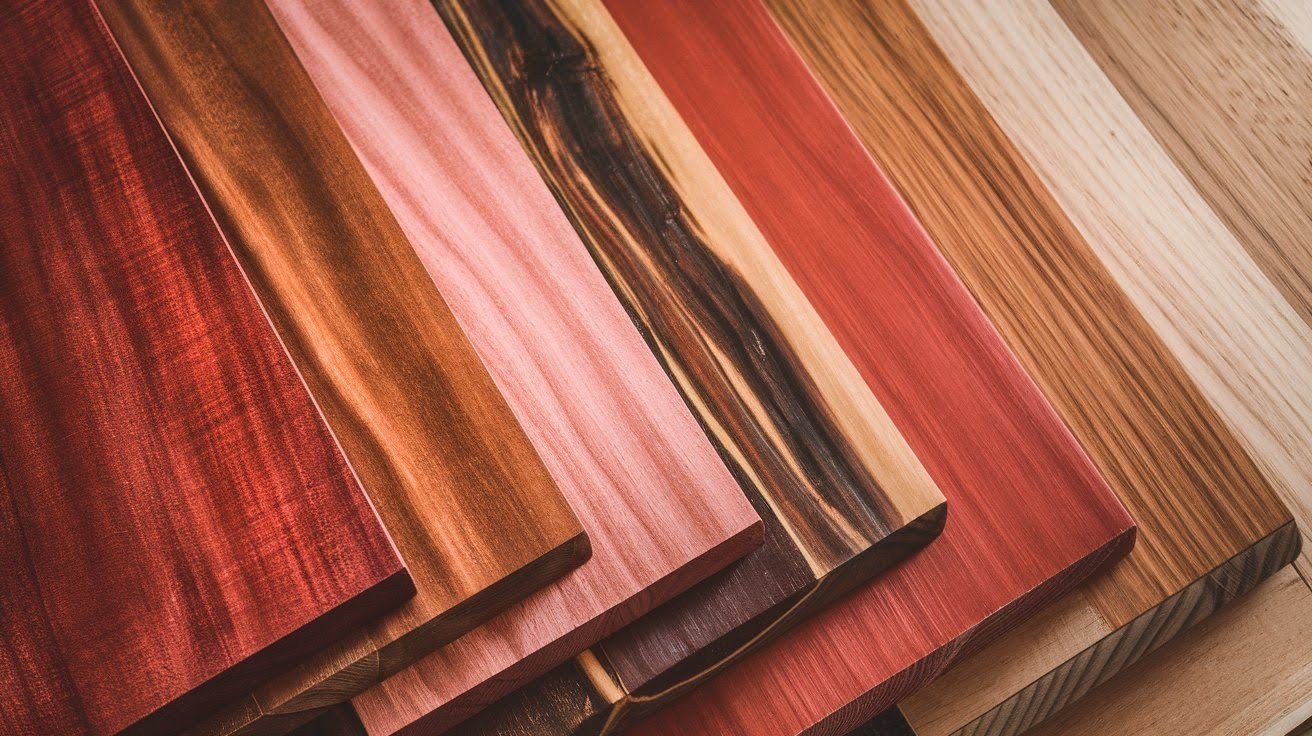
Redwoods bring instant warmth to any room. I’ll show you the best options for creating cozy spaces. Bloodwood starts bright red but darkens over time. Perfect for accent pieces that age beautifully.
Sapele and Bubinga offer softer pink-red tones. These work well in bedrooms and living areas. African Padauk ranges from pale orange to deep red-brown. Great for statement furniture.
Redwood and Red Oak provide classic reddish-brown looks. These are budget-friendly choices. Red Alder starts light tan but turns reddish with age. Ideal for cabinets that improve over time.
Orange Wood Tones
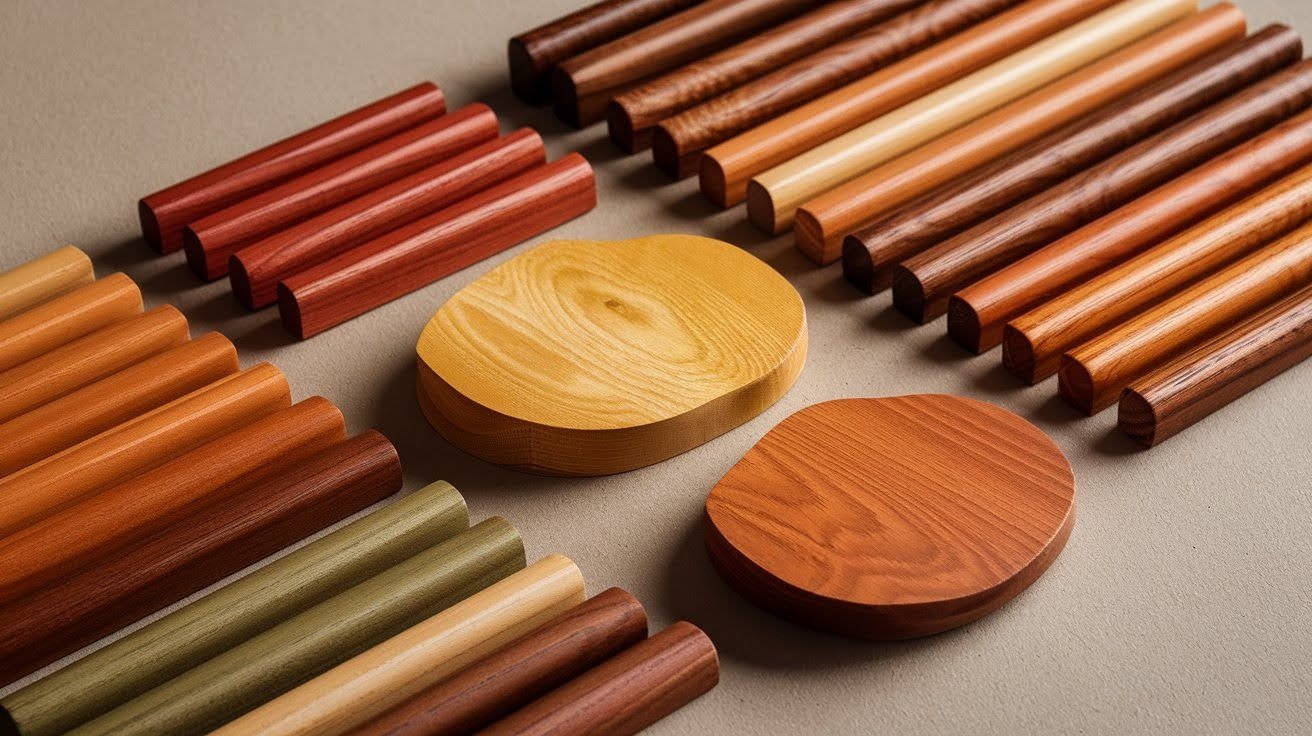
Orange woods add sunshine to your home. I’ll explain how these vibrant tones work in different spaces. Cherry wood is the premium choice. It starts pale orange but darkens to rich brown when exposed to light. This change happens naturally over months.
Osage orange gives you golden yellow heartwood. It’s incredibly durable and bright. Yellow poplar improves from green to brown-orange. This affordable option works well for painted projects.
Each type changes color differently with time and light exposure.
Exotic Color Variations
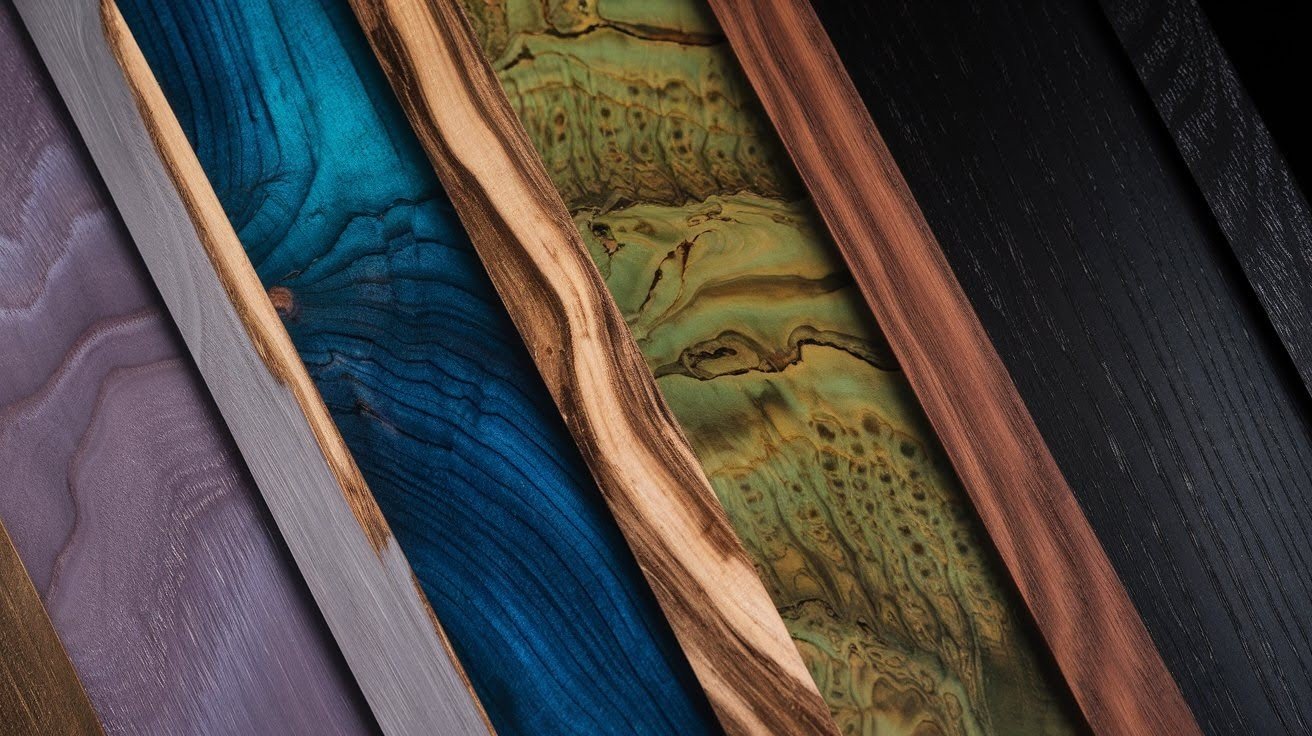
Want something truly different? I’ll show you woods that break all the rules. Purple heartwood ranges from dull gray to deep eggplant. Perfect for creating striking focal points.
Blue Mahoe offers rare blue tones. This wood is incredibly hard to find but worth the search. Greenheart and lignum vitae display olive green patterns. These create natural, earthy accents.
Ebony and African blackwood provide dramatic black finishes. Use sparingly for maximum impact. These exotic options cost more but enhance ordinary rooms into eye-catching ones.
Room-by-Room Wood Tone Inspiration
Learn about how to choose the right wood tones for every room, balancing color, texture, and mood for cohesive home design.
Living Room Wood Tone Coordination
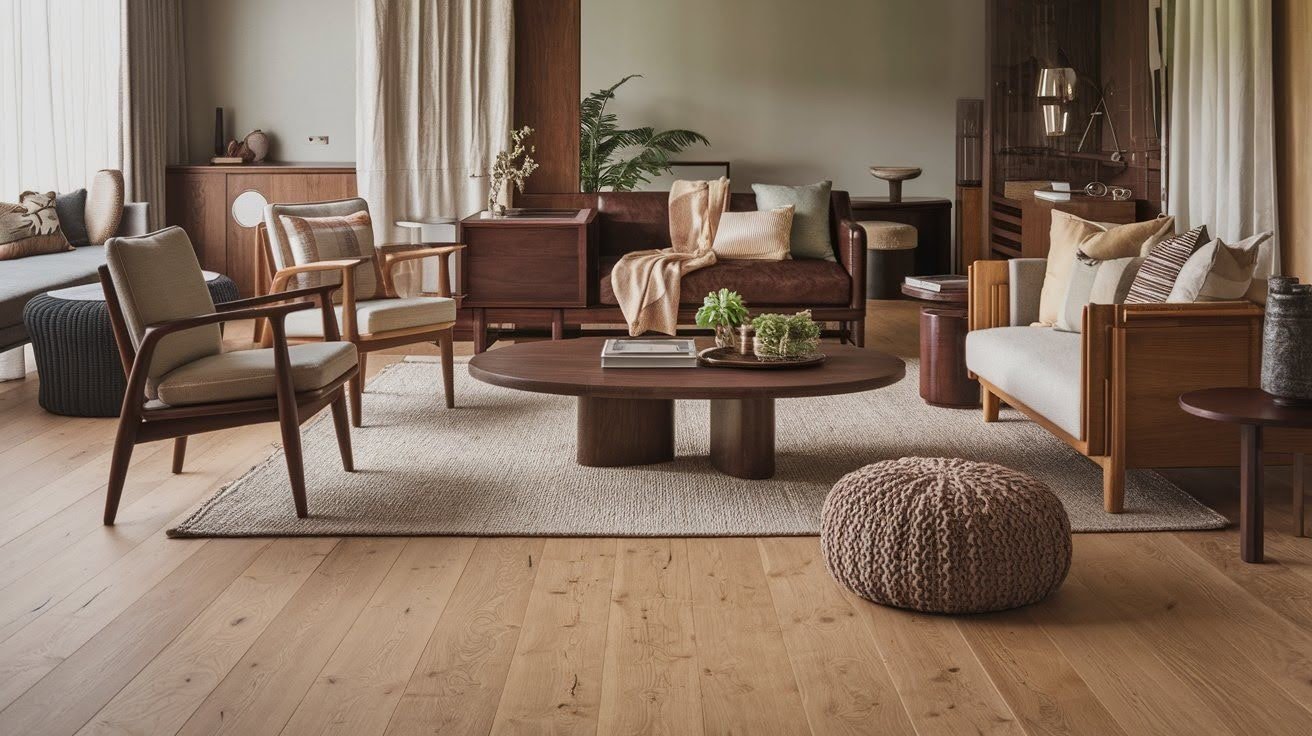
Your living room needs a cohesive wood strategy. I’ll show you how to make it work perfectly. Create focal points with contrasting tones. Dark walnut coffee table against light oak floors? That’s a visual drama done right.
Balance your flooring with furniture pieces. Match undertones, not exact colors. Warm floors need warm furniture tones. Mix warm and cool tones carefully. Use the 70-30 rule: 70% warm, 30% cool for best results.
Coordinate with your existing colors. Blue walls love honey maple. Gray walls pair beautifully with dark cherry. The key is harmony, not matching everything perfectly.
Kitchen and Dining Area Applications
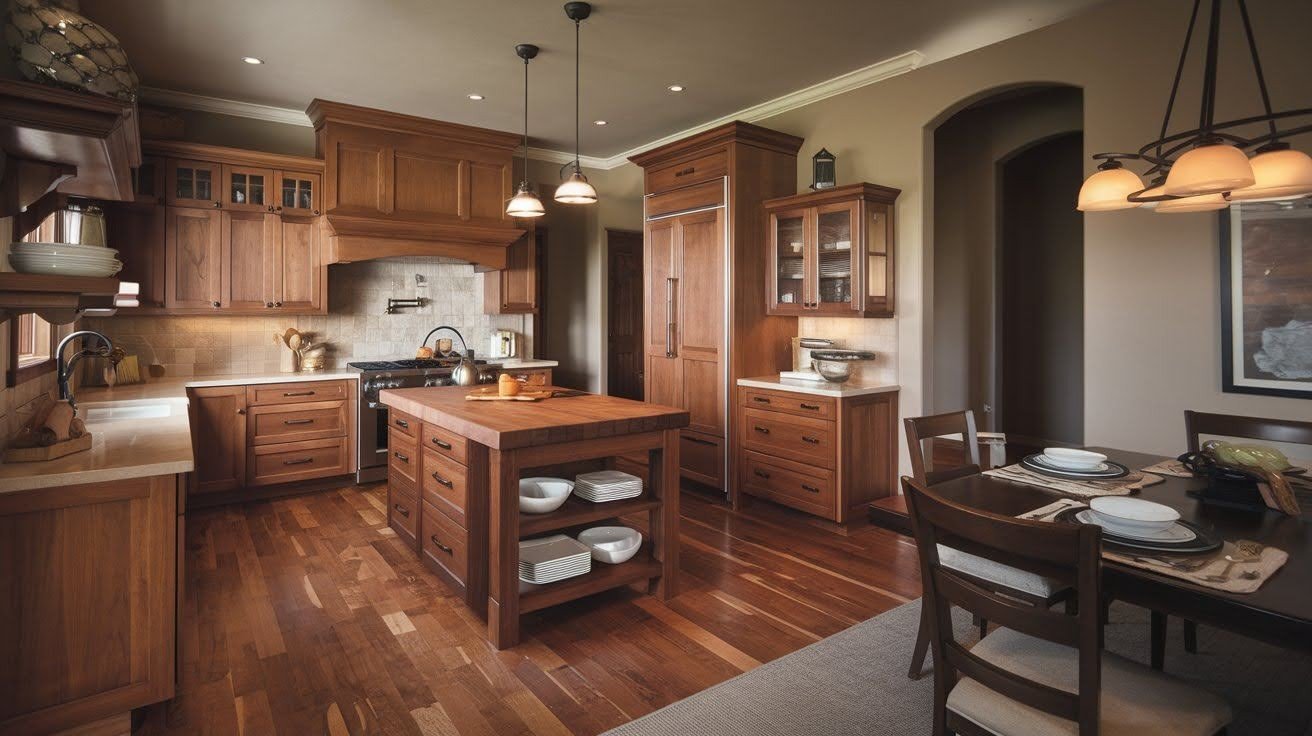
Kitchens need wood tones that handle daily life. I’ll show you which ones work best. Warm cherry and oak create inviting cooking spaces. These tones make your kitchen feel like home, not a showroom.
Light maple and birch give you a modern, clean look. Perfect for minimalist designs and small spaces. Dark Walnut adds sophistication to dining areas. This rich tone makes every meal feel special.
Mixing wood tones requires careful planning. Keep cabinets and flooring at the same temperature. Warm with warm, cool with cool. Pro tip: Test samples in your actual lighting before committing to any wood tone.
Bedroom and Private Space Ideas
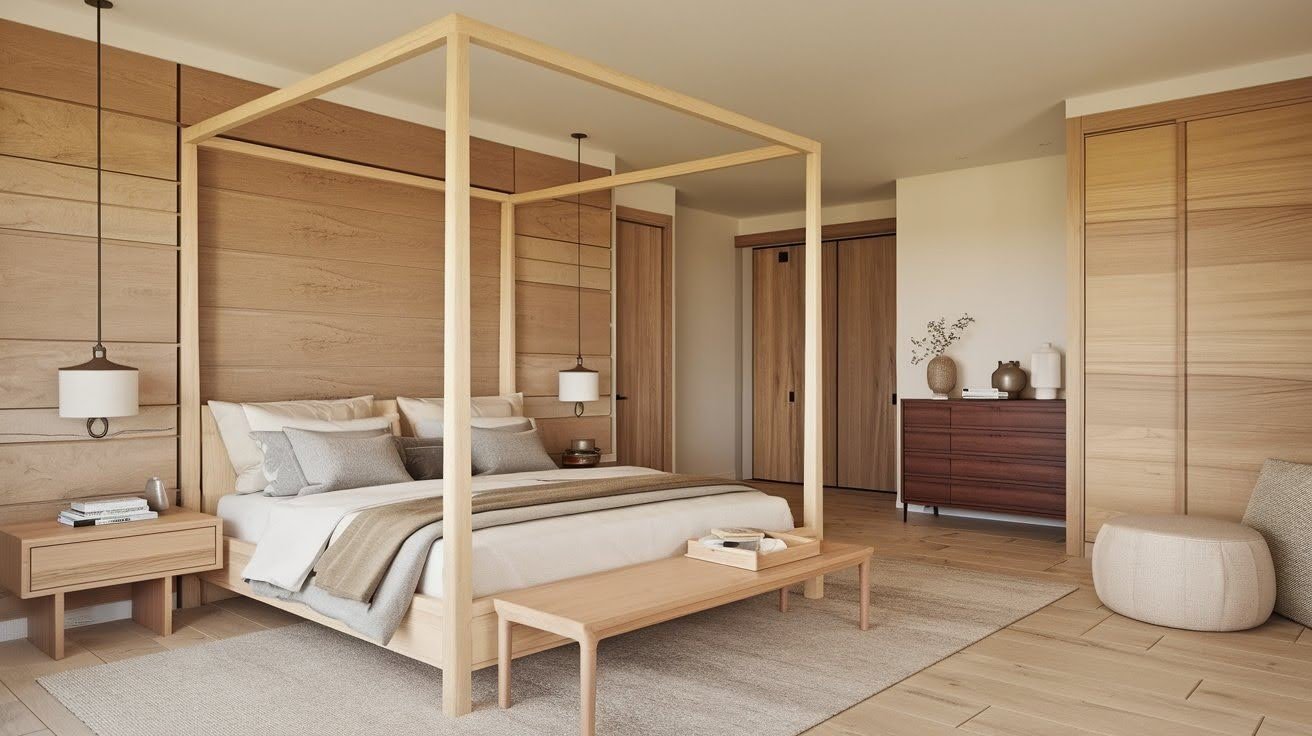
Bedrooms need wood tones that promote rest. I’ll help you choose colors that improve your sleep. Calming light wood creates peaceful environments. Pale ash and blonde maple reduce stress and open up small bedrooms.
Rich mahogany and cherry work in master suites. These deep tones add luxury without overwhelming the space. Natural pine and cedar build cozy retreats. Perfect for cabins or anyone wanting that rustic feel.
Bamboo and light oak suit minimalist designs. Clean lines and pale tones keep distractions away. Remember this: Darker woods absorb light, lighter woods reflect it. Choose based on your room’s natural lighting.
Bathroom and Specialty Area Concepts
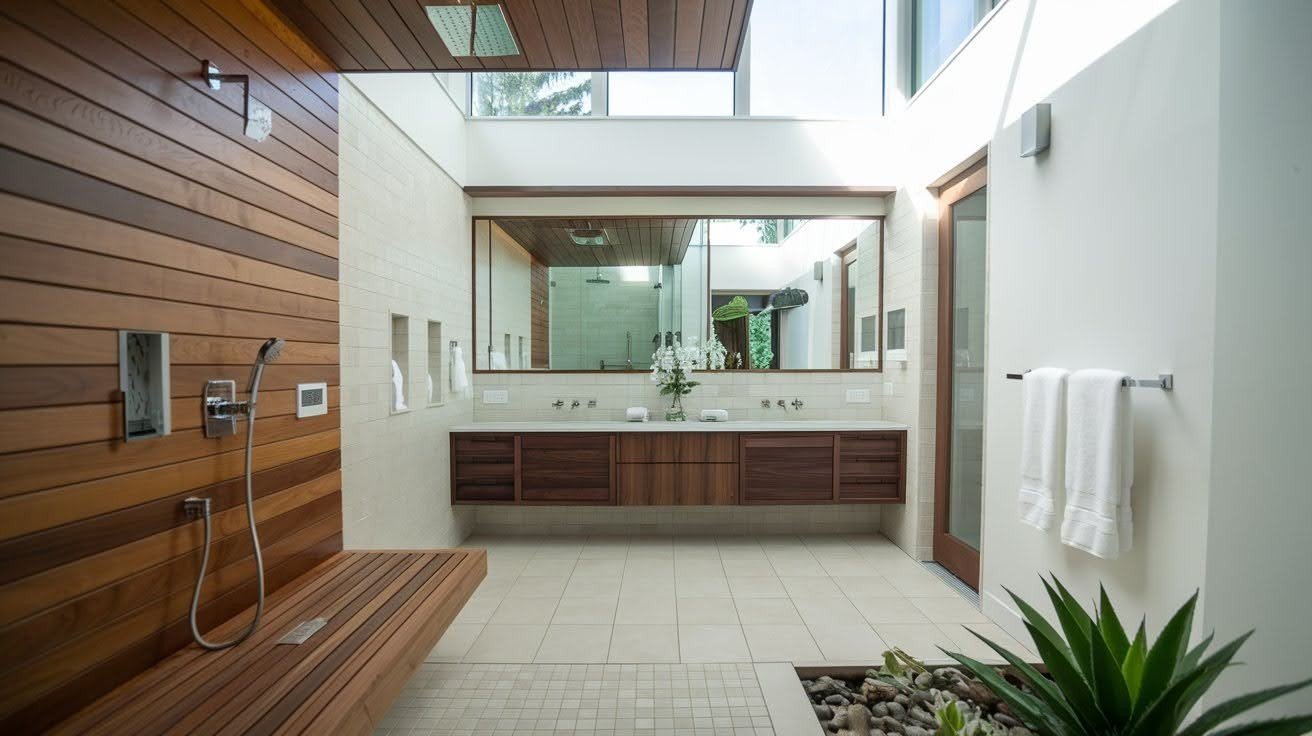
Bathrooms demand moisture-resistant wood choices. I’ll show you which ones survive steam and splashes. Teak and cedar handle humidity naturally. These woods contain oils that repel water and prevent rot.
Light wood tones create spa-like feelings. Pale bamboo and bleached oak make small bathrooms feel larger and more relaxing. Accent walls using reclaimed wood add character. Just seal them properly against moisture damage.
Floating vanities in contrasting tones make bold statements. Dark walnut vanity against light tile walls? That’s instant drama. Critical warning: Always use marine-grade finishes in bathrooms, regardless of wood type.
Design Style Applications
Learn how to match wood tones with popular design styles, modern, rustic, classic, and more, for a seamless, stylish home look.
Modern and Contemporary Spaces
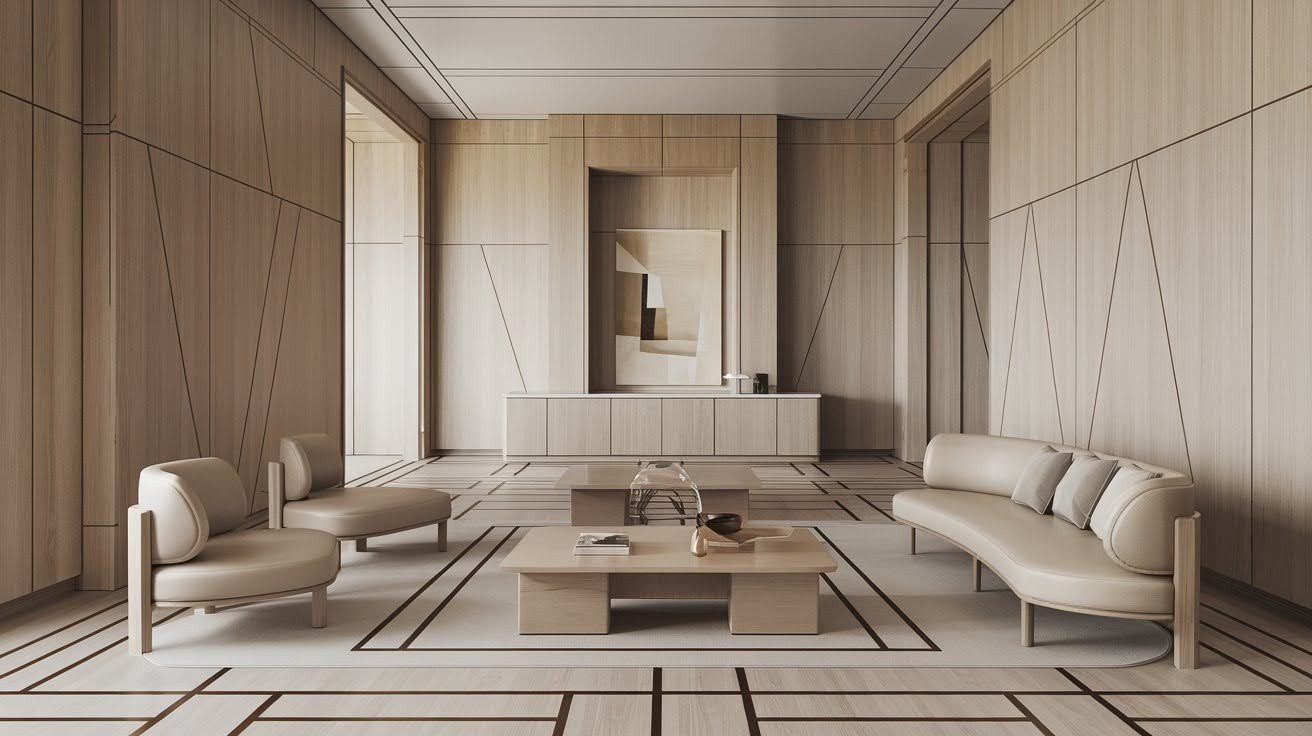
Modern design loves clean, simple wood tones. I’ll show you how to get that sleek look right. Light ash and maple create perfect clean lines. These pale tones complement glass and steel beautifully.
Minimalist approaches work best with a single wood species. Pick one tone and stick with it throughout the space. Geometric patterns using contrasting colors add visual interest. Think light and dark squares or stripes.
Sleek finishes highlight natural grain patterns. Satin or semi-gloss brings out the wood’s beauty without overwhelming your design.
Traditional and Classic Interiors
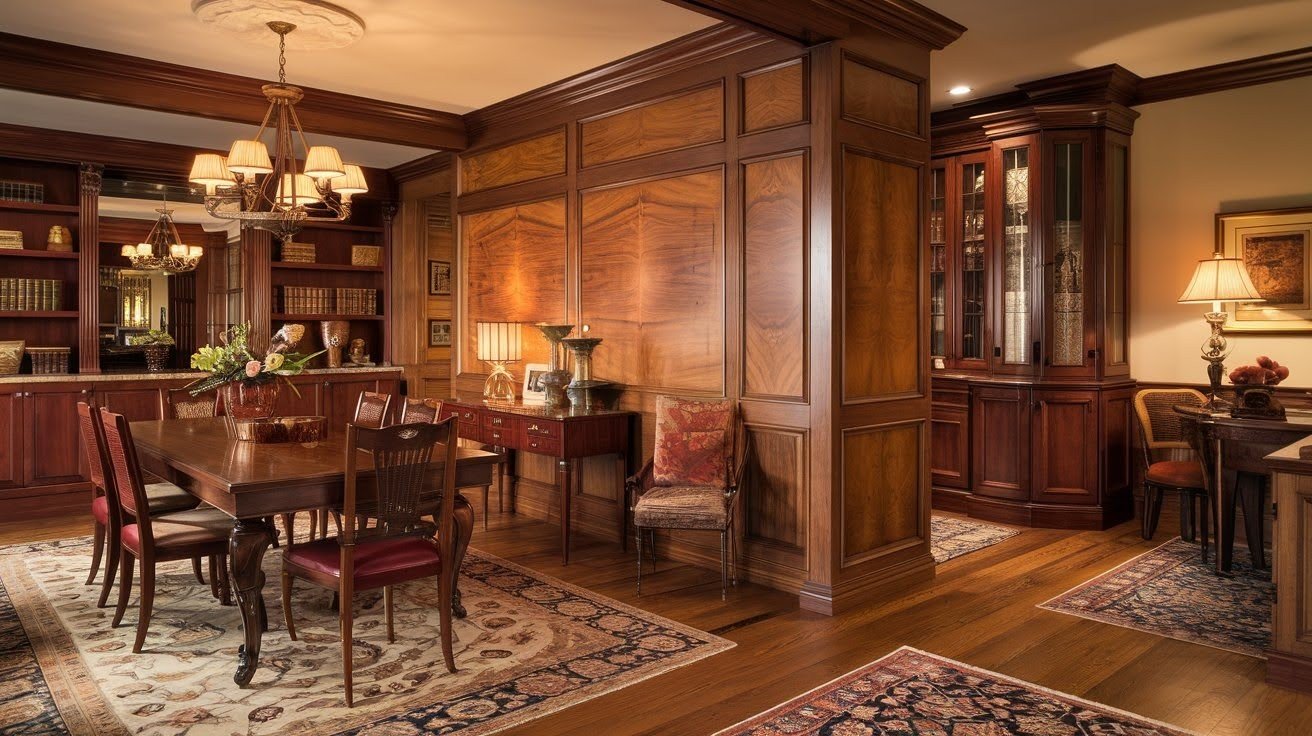
Traditional spaces call for rich, established wood tones. I’ll help you create that timeless elegance. Rich mahogany and cherry work perfectly in formal settings. These deep colors add instant sophistication to dining rooms and libraries.
Oak and Walnut provide timeless appeal. These classics never go out of style and age beautifully. Layering different brown tones creates visual depth. Mix light, medium, and dark browns for interest.
Ornate grain patterns become decorative features. Let the wood’s natural beauty shine as artwork.
Rustic and Farmhouse Aesthetics
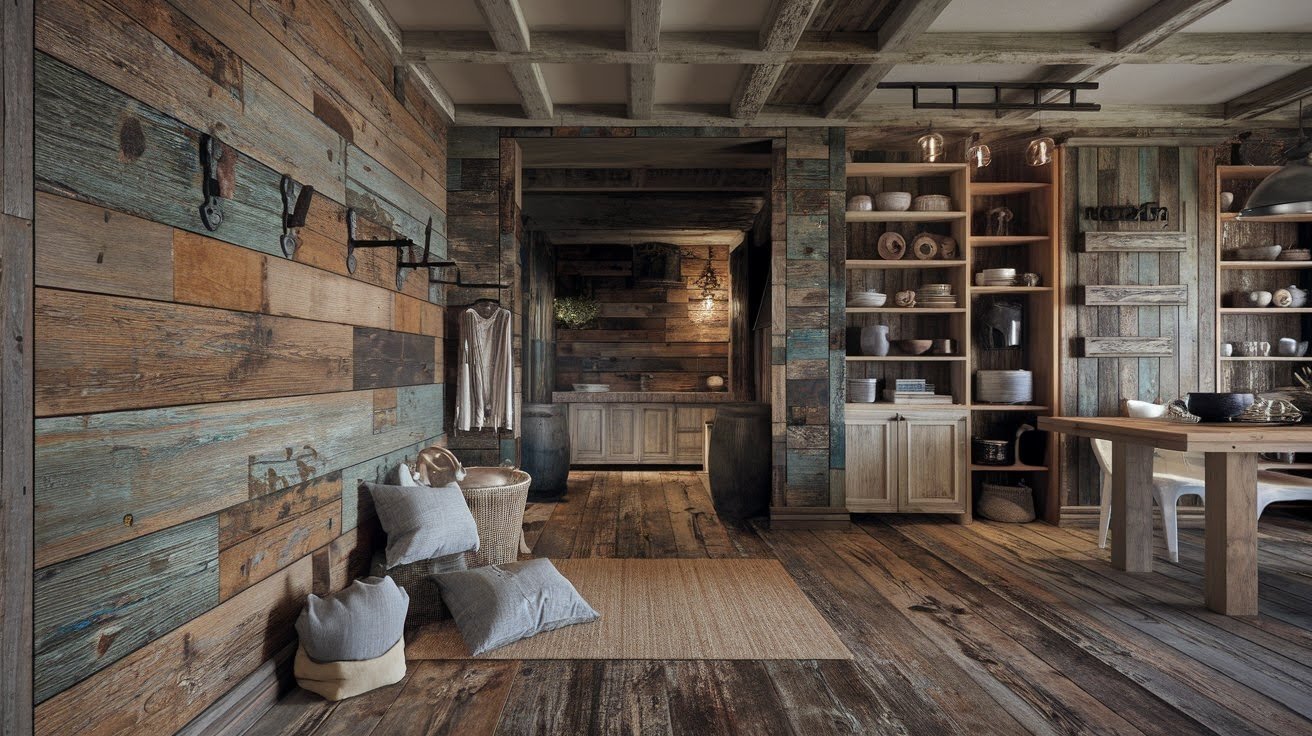
Rustic design celebrates wood’s natural imperfections. I’ll show you how to make weathered wood look intentional. Reclaimed wood with natural aging tells stories. Each scratch and stain adds character you can’t fake.
Mixing weathered and new wood creates an authentic contrast. Combine barn wood with fresh pine for perfect balance. Pine and cedar deliver that authentic country feel. These affordable options work in any farmhouse space.
Distressed finishes show wood’s true character. Embrace knots, cracks, and color variations as features, not flaws.
Industrial and Urban Loft Designs
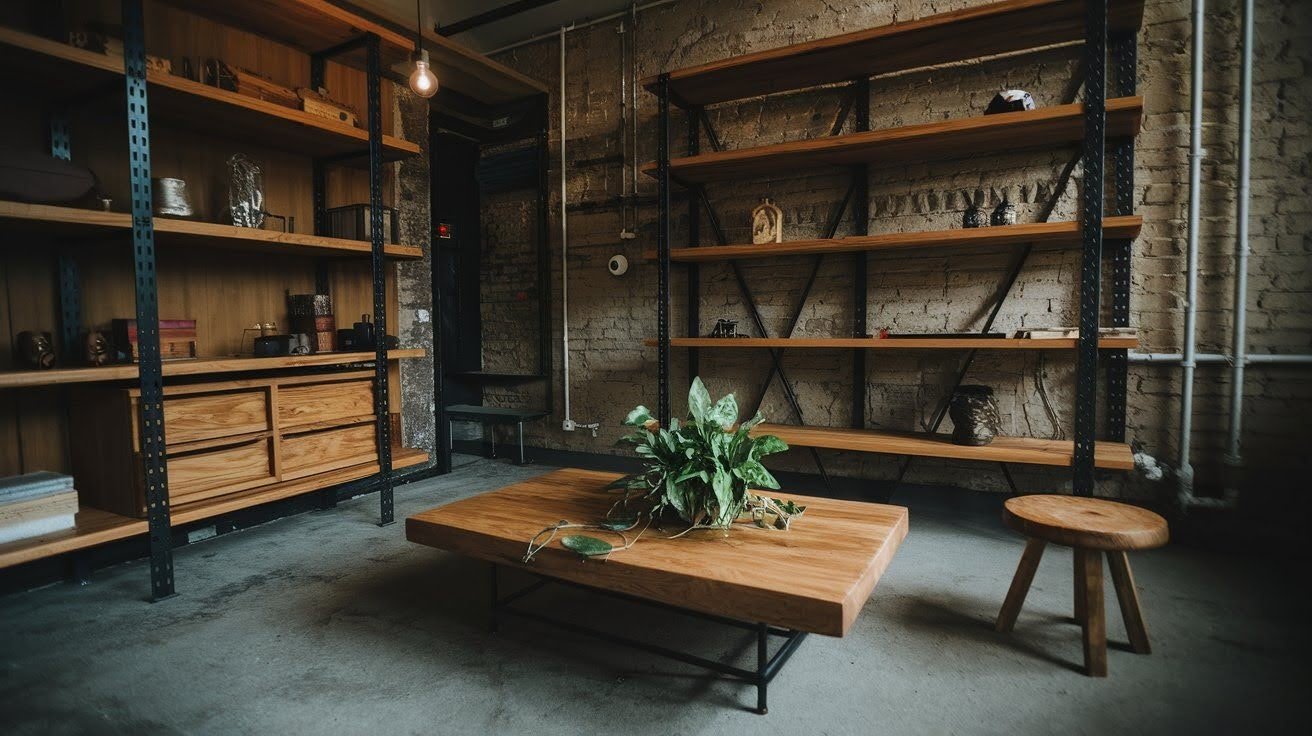
Industrial spaces need raw, honest wood tones. I’ll show you how to balance warmth with urban edge. Raw, unfinished wood works as a perfect accent. Skip the polish and let natural texture shine through.
Combining wood with metal and concrete creates stunning contrasts. Warm oak against cold steel? That’s industrial magic. Dark ebony and blackwood provide a dramatic impact. These deep tones complement exposed brick beautifully.
Exposed beams in natural colors add structural interest. Leave them untreated for authentic industrial character.
Wood Tone Coordination Strategies
Master the art of mixing wood tones by learning coordination rules, undertone matching, and layout balance for a harmonious home design.
Creating Harmony with Multiple Wood Elements
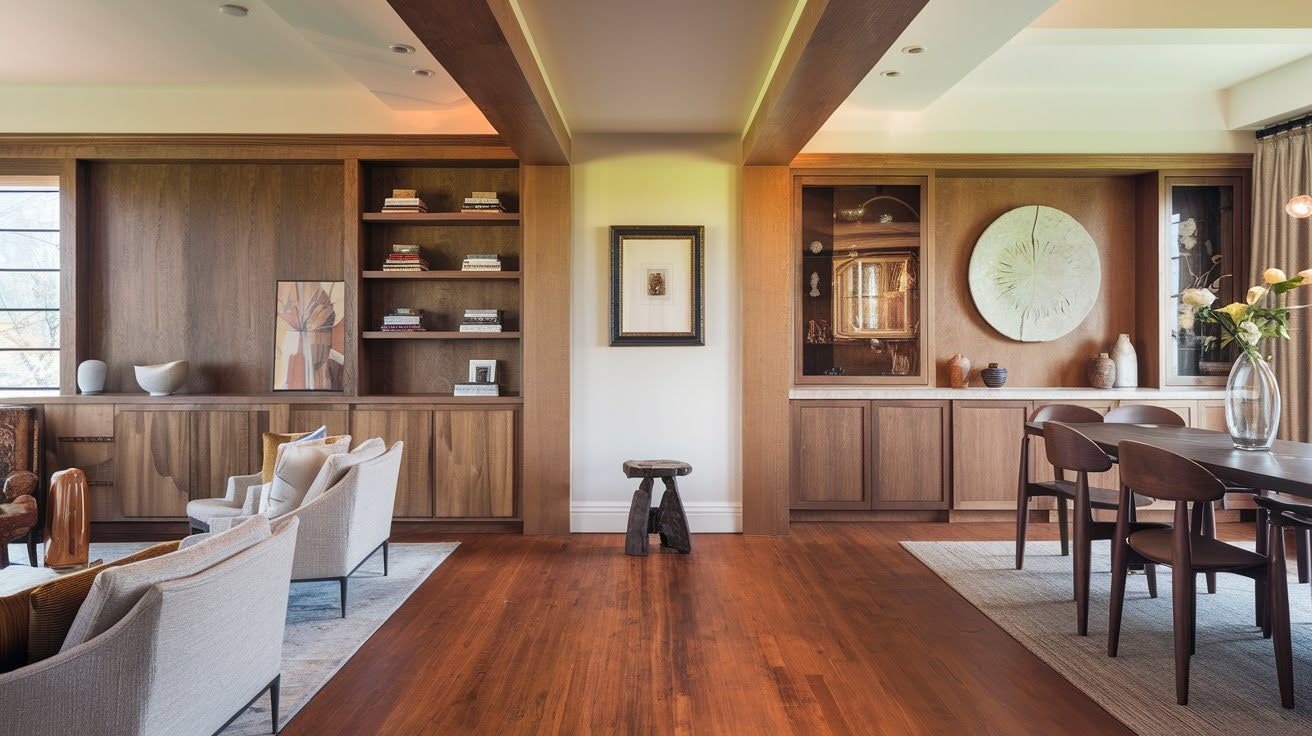
Multiple wood tones can work together beautifully. I’ll teach you the rules that prevent chaos. Coordinate flooring with furniture and trim by matching undertones. Red oak floors need warm furniture, not cool ash pieces.
Balance warm and cool undertones using the 80-20 rule. Pick one temperature family as your dominant choice. Use the 60-30-10 rule for distribution, 60% main tone, 30% secondary, 10% accent wood.
Transition between different areas gradually. Sudden wood changes look jarring and unplanned.
Accent and Statement Piece Integration
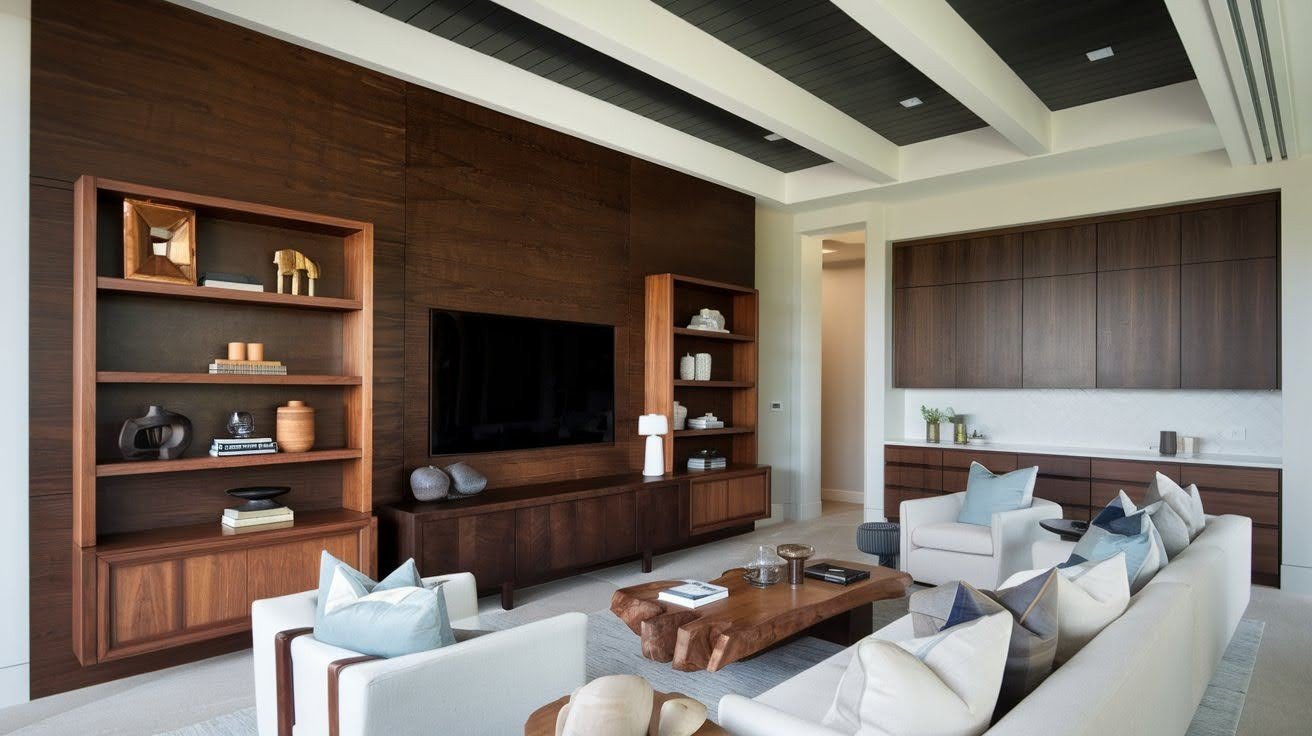
Statement pieces need bold wood choices. I’ll show you how to make them work without overwhelming your space. Featured walls using dramatic tones create instant impact. Dark Walnut against light walls? That’s eye-catching material.
Furniture pieces become color focal points naturally. One rich mahogany bookshelf can anchor an entire room. Ceiling treatments with contrasting wood add unexpected drama. Light beams against dark ceilings flip traditional design rules.
Built-in elements should coordinate with your overall scheme. Match undertones, not exact colors, for cohesive flow.
Trending Wood Tone Combinations
Learn about the top wood tone combinations for 2024-2025, from bold contrasts to subtle blends, perfect for modern and timeless interiors.
Popular Color Pairings for 2024-2025
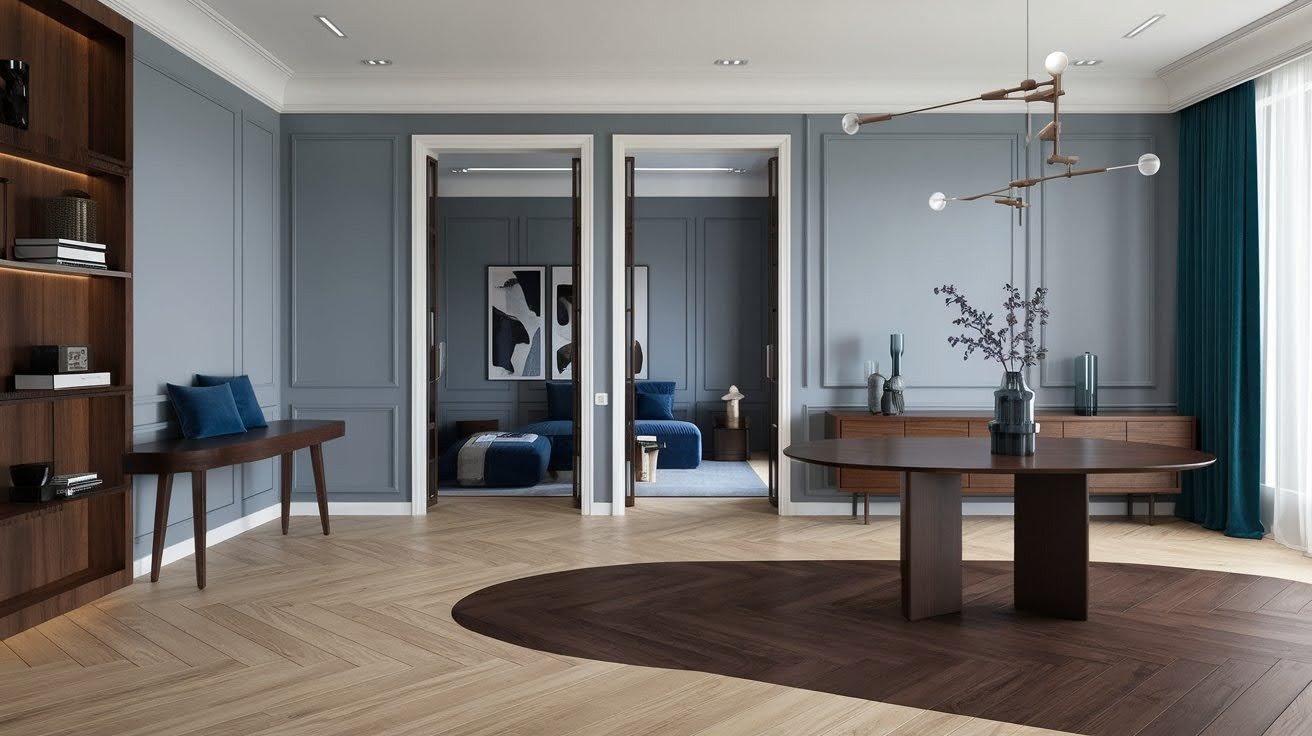
Current trends favor bold wood contrasts. I’ll show you what’s working right now. Mixing light and dark woods creates a stunning visual impact. Blonde oak with deep walnut is everywhere in modern homes.
Monochromatic schemes using single-species variations look classic. Different cherry stains maintain harmony while adding depth. Complementary combinations with wood undertones work
beautifully.
Cool gray walls with warm honey maple? Perfect balance. Accent colors enhance natural wood beauty. Deep blues make oak glow.
Timeless Combinations That Always Work
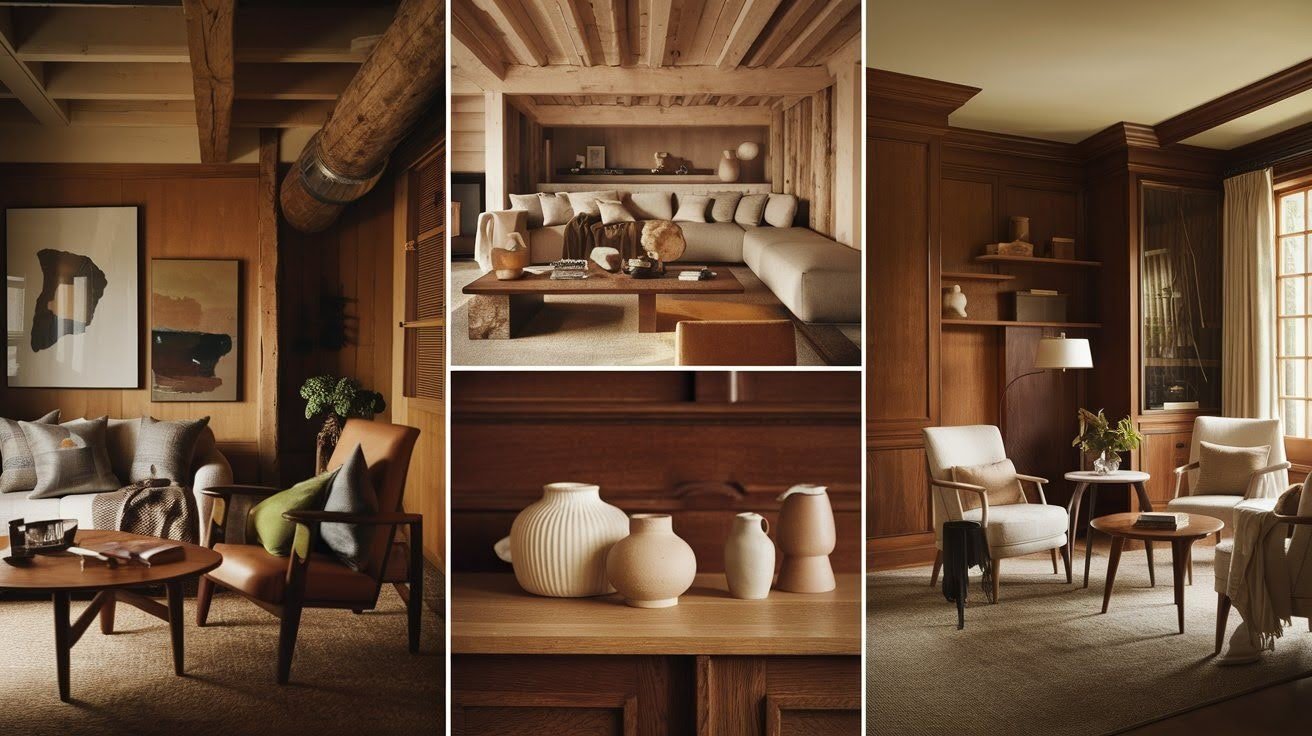
Some wood pairings never go out of style. I’ll share the classics that work in any home. Classic oak and cherry pairings create warm, inviting spaces. This combination has worked for decades and still looks fresh.
Maple and Walnut contrasts offer a perfect light-dark balance. These opposites complement each other beautifully. Pine and cedar rustic combinations feel naturally authentic. Ideal for cabins or farmhouse styles.
Mahogany with lighter wood accents adds a classic look of depth. A rich base with bright highlights never fails.
Conclusion
You now have everything you need to choose perfect wood tones for your home. This wood tones chart takes the guesswork out of matching colors, coordinating rooms, and creating beautiful spaces.
Remember the key principles: match undertones, not exact colors. Use the 60-30-10 rule for distribution, test samples in your actual lighting before making final decisions.
Your wood tone confusion is officially solved. No more second-guessing or expensive mistakes. Just confident choices that enhance your space exactly how you imagined.
Ready to start your wood tone refreshments? Share this guide with friends who are also planning home projects. And if you have questions about specific combinations, drop a comment below. I’d love to help you create the perfect look for your unique space.
Frequently Asked Questions
What is a wood tones chart, and why do I need one?
A wood tones chart shows different wood colors from light to dark, helping you match furniture, flooring, and trim. It prevents costly mistakes and ensures your rooms look cohesive and professional.
How do I match different wood tones in the same room?
Focus on matching undertones rather than exact colors. Use the 60-30-10 rule: 60% main tone, 30% secondary, 10% accent. Keep warm woods with warm, cool with cool.
Can I mix light and dark wood tones?
Yes! Mixing light and dark woods creates a beautiful contrast. Popular combinations include blonde oak with Walnut, or light maple with cherry. Just ensure they share similar undertones.
Which wood tones work best in small spaces?
Light wood tones like maple, ash, and pine make small spaces feel larger and brighter. Avoid dark woods in tiny rooms as they absorb light and create cramped feelings.
What are the most popular wood tone combinations for 2024-2025?
Trending combinations include light oak with dark walnut, monochromatic cherry variations, and maple with walnut contrasts. Classic pairings like oak and cherry remain timeless choices.

